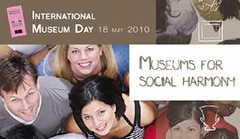 Like most museums, Medical Museion is a member of the International Council of Museums (ICOM). The major benefit of membership is that you don’t have to pay entrance to other member museums (and sometimes are allowed to bypass the queue by getting in through the VIP entrance, which gives a kick of feeling important).
Like most museums, Medical Museion is a member of the International Council of Museums (ICOM). The major benefit of membership is that you don’t have to pay entrance to other member museums (and sometimes are allowed to bypass the queue by getting in through the VIP entrance, which gives a kick of feeling important).
But except for this, one doesn’t really get much out of the hefty membership fee. ICOM, with its headquarters in the UNESCO building in Paris, is just another big transnational bureaucracy.
In the good old days of Western imperialism, ICOM promoted wholesome European and American values. Not so anymore. The 22nd General Conference will be held in Shanghai in November this year on the theme ‘Museums for Social Harmony’.
 Took me some time to get my memory in order. In fact, last I heard the term ‘social harmony’ was in a Xinhua news report from the Sixth Plenum of the 16th Central Committee meeting of the Chinese Communist Party, held in Beijing in 2006.
Took me some time to get my memory in order. In fact, last I heard the term ‘social harmony’ was in a Xinhua news report from the Sixth Plenum of the 16th Central Committee meeting of the Chinese Communist Party, held in Beijing in 2006.
Building social harmony, said a CPC spokesperson then, “is a major strategic move taken by the Party to build a fair and just society and attain sustainable social and economic development”. And now, four years later, this strategic move has already been adopted by ICOM.
 As a corollary, ‘Museums for Social Harmony’, has also been chosen as the theme for this year’s International Museum Day on Tuesday 18 May.
As a corollary, ‘Museums for Social Harmony’, has also been chosen as the theme for this year’s International Museum Day on Tuesday 18 May.
Actually, when you think about it, it’s not that surprising. I don’t believe this is a specific ICOM phenomenon. Transnational bureaucracies probably have quite a lot in common with CPC’s world view of a socially harmonic, authoritarian, market economy-based society.

 Technology and Medical Practice: Blood, Guts and Machines, edited by Ericka Johnson och Boel Berner (Ashgate), might be interesting reading for medical museum curators. Says the blurb:
Technology and Medical Practice: Blood, Guts and Machines, edited by Ericka Johnson och Boel Berner (Ashgate), might be interesting reading for medical museum curators. Says the blurb: